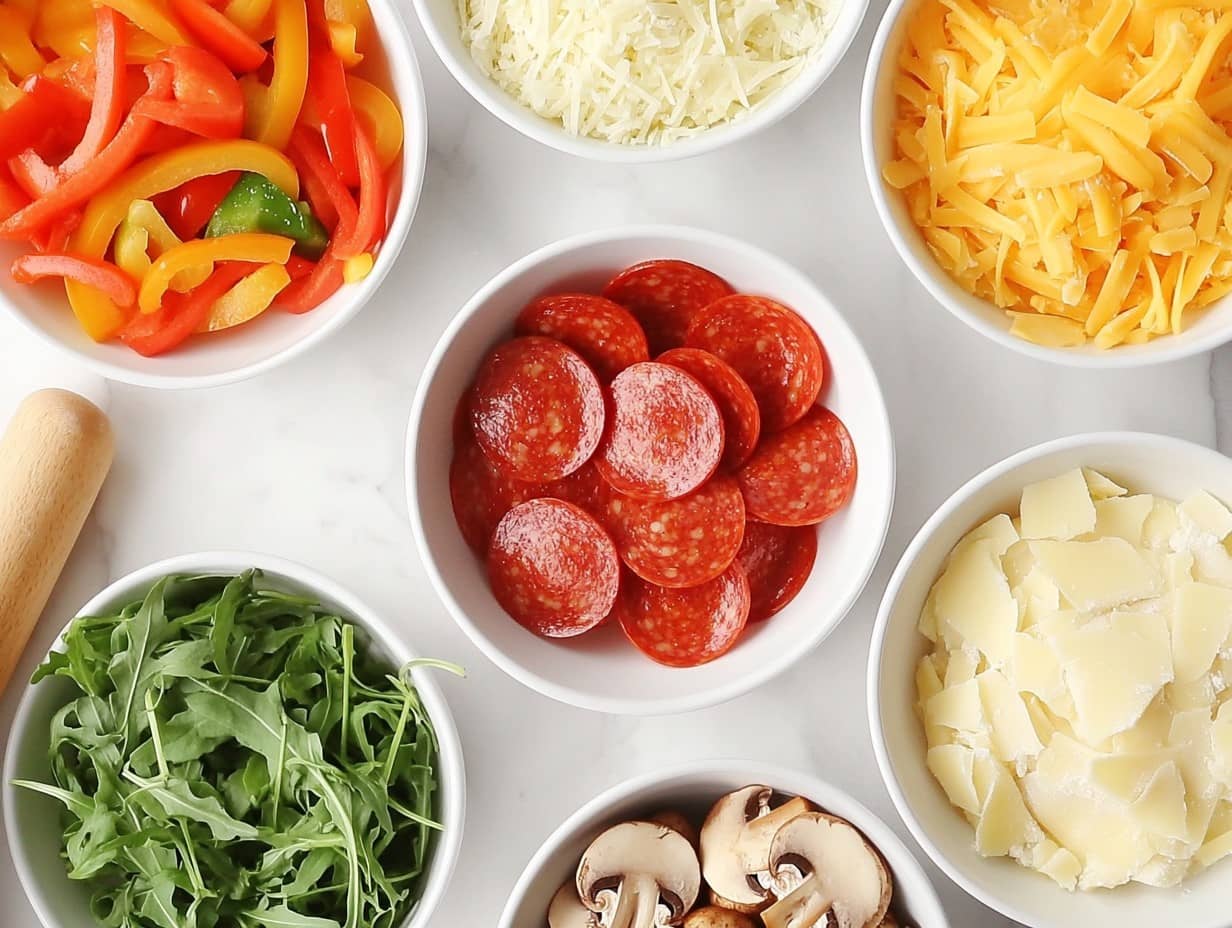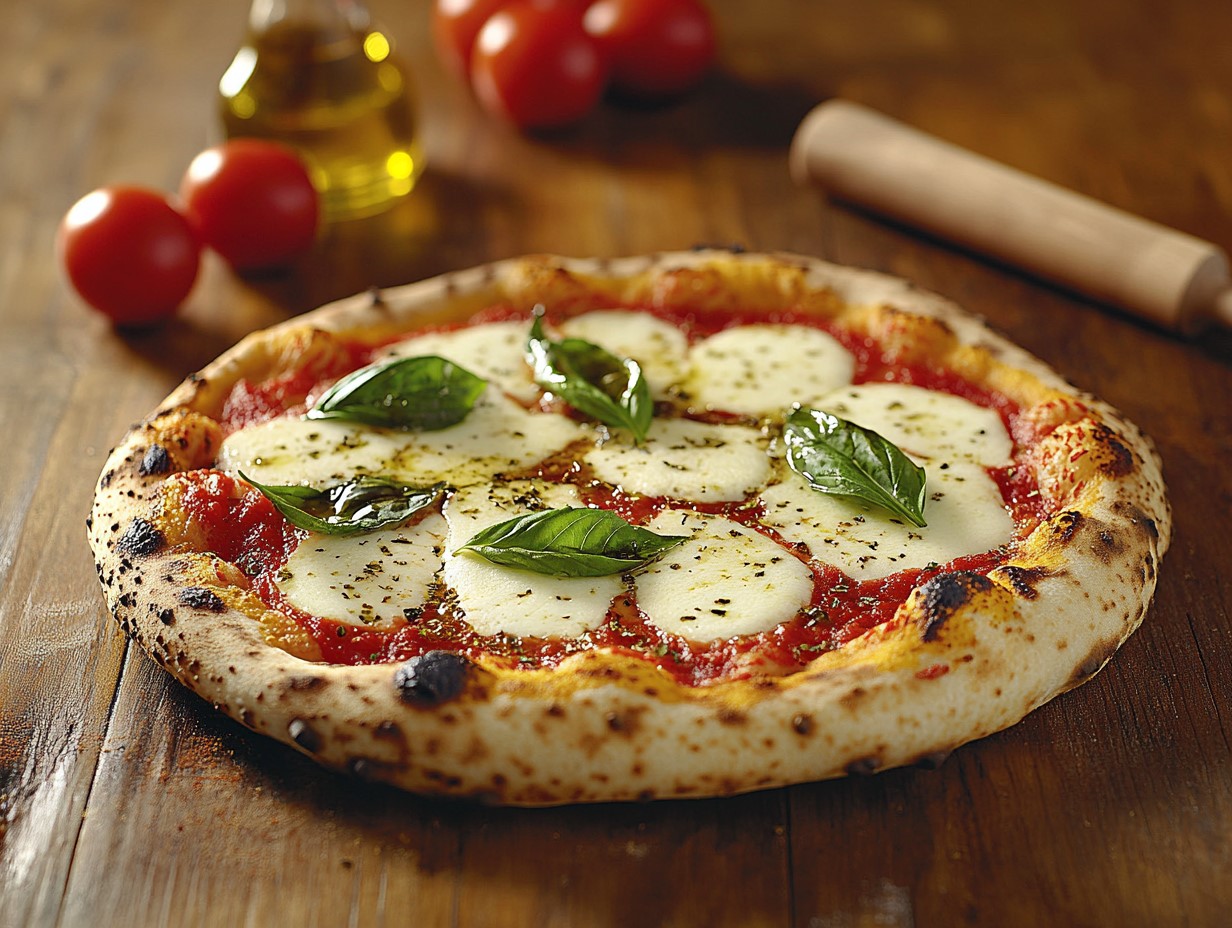What makes an amazing pizza? Pizza, oh, the word itself is enough to make mouths water! Whether you’re a fan of classic Margherita or experimental toppings, one thing’s for sure: an amazing pizza is unforgettable. But what takes a pizza from good to truly amazing? Is it the chewy yet crispy crust, the rich tomato sauce, or the perfect blend of cheese and toppings? Spoiler alert: it’s all of the above and then some. An incredible pizza is a masterpiece of flavor, texture, and quality ingredients that combine in perfect harmony. And if you love pizza innovation, check out Tasty Pizza Secrets: Mouth-Watering Tips for more inspiration.
Table of Contents
The History and Evolution of Pizza
Origins of Pizza in Italy
Pizza’s journey began in Naples, Italy, as a humble food for the working class. The word “pizza” is believed to come from the Latin “pinsa,” meaning flatbread. Originally, pizzas were simple: dough, tomatoes, and a sprinkle of cheese. But even in its simplicity, the balance of flavors made it special.
Legend has it that the classic Margherita pizza was created in honor of Queen Margherita of Savoy in 1889. Its tri-color toppings red tomato sauce, white mozzarella, and green basil represented the Italian flag. 🇮🇹
“Pizza is not just food; it’s a slice of history you can taste.”
Global Adaptations and Influence
From New York’s foldable slices to Chicago’s deep dish, pizza has taken on many delicious forms around the world. Each culture has added its spin: think Indian naan pizzas or Japanese okonomiyaki-style pies. Despite these variations, the essence of an amazing pizza remains universal quality ingredients and a passion for flavor.
Key Elements of an Amazing Pizza
The Perfect Pizza Dough
The foundation of any pizza lies in its dough. Great pizza dough is stretchy, slightly chewy, and has just the right amount of crispness.
- Ingredients:
Flour, water, salt, yeast, and olive oil. - Secret: The magic happens during fermentation. Allowing the dough to rest for 24–48 hours develops its flavor and texture.
The Importance of Sauce Quality
A bland sauce can ruin even the best dough. Use fresh, ripe tomatoes blended with garlic, basil, and a drizzle of olive oil for a vibrant flavor.
Choosing the Right Cheese
Mozzarella is a classic choice, but don’t shy away from experimenting with ricotta, provolone, or even blue cheese. Cheese brings creaminess and that irresistible stretch we all love. 🧀
Creative and Balanced Toppings
While pepperoni and mushrooms are timeless, think outside the box! Roasted veggies, figs, or even truffle oil can elevate your pizza game. But remember, balance is key too many toppings can overwhelm the crust.
The Art of Pizza Dough: Tips and Tricks
The dough forms the base of any great pizza. With just a few ingredients flour, water, yeast, and salt the magic happens during fermentation. If you want to explore different textures and techniques, What Makes Pizza More Tasty? shares unique tricks to elevate your dough game.
Achieving the Ideal Dough Consistency
Ever wonder why some dough tears easily while others stretch beautifully? The secret lies in hydration. Aim for a dough hydration level of around 65–70%. This ensures elasticity without stickiness.
Fermentation and Flavor Development
Long fermentation is the key to a flavorful crust. Allowing your dough to ferment in the refrigerator slows down the yeast activity, giving it time to develop complex, tangy flavors.
“Great dough is like fine wine it only gets better with time.”
Secrets to a Flavorful Pizza Sauce
A pizza sauce should be simple yet rich. Tomatoes, garlic, basil, and olive oil combine to create a flavorful base. Curious about pairing sauces with creative toppings? Explore What is the Most Tasty Pizza? for more inspiration.
Using Fresh Ingredients for the Best Results
Canned tomatoes can work in a pinch, but fresh tomatoes bring a bright, natural sweetness. Roast them with garlic and olive oil for added depth.
Exploring Herbs and Spices
Basil and oregano are classics, but don’t be afraid to add a pinch of chili flakes or a dash of smoked paprika for an unexpected twist.
Cheese Selection: The Heart of an Amazing Pizza
The cheese is the heart of an amazing pizza. From creamy mozzarella to sharp Parmesan, every type of cheese tells a different story. Learn more about cheese combinations in What is the Tasty Pizza?.
Classic Cheese Choices: Mozzarella and Beyond
Fresh mozzarella is a staple, but aged varieties like Parmesan or Asiago can add nuttiness and depth.
Pairing Cheeses with Different Toppings
Love savory? Pair goat cheese with caramelized onions. Prefer bold flavors? Try Gorgonzola with sliced pears. The possibilities are endless!
Table: Nutritional Facts of Classic Pizza Ingredients
| Ingredient | Calories (per 100g) | Key Nutrients |
|---|---|---|
| Pizza Dough | 250 | Carbs, Protein, Fiber |
| Tomato Sauce | 40 | Vitamin C, Lycopene |
| Mozzarella Cheese | 280 | Protein, Calcium, Vitamin B |
| Olive Oil | 120 | Healthy Fats, Vitamin E |
| Pepperoni | 500 | Protein, Sodium |
“A great pizza isn’t just delicious it can also be part of a balanced meal.”
Top Pizza Toppings That Make a Difference
From traditional toppings like pepperoni and mushrooms to bold options like figs and arugula, toppings transform a good pizza into a memorable one. For innovative topping ideas, visit What Makes an Amazing Pizza?.

Traditional Favorites
Some toppings are classics for a reason. Think pepperoni, mushrooms, bell peppers, olives, and onions. Each brings a distinct flavor profile that balances beautifully with the dough, sauce, and cheese.
- Pepperoni: Its slightly spicy, smoky flavor complements the richness of the cheese.
- Mushrooms: Earthy and umami-packed, mushrooms add depth.
- Bell Peppers: These offer a touch of sweetness and a vibrant crunch.
Unique and Modern Combinations
Want to step out of your comfort zone? Try innovative toppings like figs, arugula, or prosciutto.
- Figs and Blue Cheese: A sweet-savory combo that’s utterly indulgent.
- Arugula and Parmesan: Perfect for those who love a fresh, peppery bite.
- Barbecue Chicken: A crowd-pleaser, combining smoky barbecue sauce with tender chicken and red onions.
“The right toppings can turn a good pizza into an unforgettable one.”
Tools and Techniques for the Best Pizza Experience
Having the right tools and knowing the techniques can elevate your pizza-making to a pro level.
The Role of Pizza Stones and Ovens
A pizza stone helps evenly distribute heat, mimicking the effects of a wood-fired oven. If you’re serious about your pizza game, consider investing in a pizza steel it retains heat even better than stone.
For ovens, the hotter, the better. Preheat your oven to its highest setting (typically 500°F or 260°C). If you’re lucky enough to have a wood-fired oven, aim for temperatures around 900°F (485°C).
Techniques for Even Cooking
To prevent soggy crusts, preheat your pizza stone and avoid overloading your pizza with sauce or toppings.
- Pro Tip: Brush the edges of your crust with olive oil for a golden, crispy finish.
- Rotation Matters: Rotate your pizza halfway through cooking for even results.
Common Problems in Making Pizza and Their Solutions
Every home chef has faced pizza-making mishaps. But don’t worry these fixes will save your slice!
Dough That’s Too Sticky or Dry
- Sticky Dough Fix: Add a bit more flour, a tablespoon at a time, until it’s manageable but still soft.
- Dry Dough Fix: Knead in small amounts of water or olive oil.
Burnt Crusts and Underwhelming Toppings
- Burnt Crust: Lower your oven temperature slightly or reduce baking time by 2–3 minutes.
- Underwhelming Toppings: Sprinkle toppings evenly and avoid overcrowding to ensure every bite is flavorful.
“Pizza mistakes are just happy accidents waiting for a creative solution.”
How to Experiment and Personalize Your Pizza
Creating Signature Pizzas at Home
Think of pizza as a blank canvas. Want to create your masterpiece? Here’s how:
- Flavor Fusion: Blend cuisines, like a Mexican-inspired pizza with refried beans, cheddar, and jalapeños.
- Dietary Preferences: Make gluten-free crusts or use cauliflower for a low-carb option.
Adapting Recipes to Dietary Preferences
Whether you’re vegan, keto, or paleo, pizza can work for you!
- Vegan Pizza: Replace cheese with cashew-based or almond ricotta, and load up on veggies.
- Keto-Friendly Pizza: Use almond flour or cheese-based crusts to reduce carbs.
“The beauty of pizza is its adaptability it’s for everyone, everywhere.” 🍕
Why Homemade Pizza Can Be More Amazing than Store-Bought
Homemade pizza isn’t just delicious it’s an experience.
Control Over Ingredients and Techniques
When you make pizza at home, you choose every ingredient. Want organic flour? Done. Prefer a spicy sauce? Go for it!
The Joy of Creativity and Experimentation
There’s a special satisfaction in crafting your pizza from scratch. It’s not just about taste it’s about the journey. Plus, you can experiment with endless combinations until you find your signature pie.
“Homemade pizza is more than food; it’s a love letter to yourself.”
The Role of Presentation in Amazing Pizza
Plating and Serving Suggestions
A beautifully presented pizza makes the experience even better. Use wooden boards or ceramic plates to serve. Slice evenly for a professional touch.
Garnishes for Visual Appeal
Add a sprinkle of fresh basil, a drizzle of olive oil, or a dash of red pepper flakes right before serving. These small details make your pizza pop both in flavor and aesthetics.
Table: Ingredient Combinations for Unique Pizzas
| Pizza Style | Key Ingredients |
|---|---|
| Margherita | Tomato sauce, mozzarella, fresh basil, olive oil |
| BBQ Chicken | BBQ sauce, grilled chicken, red onions, cilantro |
| Veggie Delight | Bell peppers, mushrooms, spinach, black olives |
| Sweet & Savory | Figs, blue cheese, prosciutto, arugula |
| Spicy Pepperoni | Tomato sauce, mozzarella, pepperoni, jalapeños, honey |
“The perfect pizza combo? It’s the one that makes your taste buds dance.”
The Experience of Enjoying an Amazing Pizza
The Social and Emotional Connection of Pizza
Pizza isn’t just a dish it’s an experience that brings people together. Think about it: a Friday night with friends, a movie marathon, or a birthday celebration. 🍕 It’s always better with pizza.
Why does pizza hold such a special place in our hearts? It’s simple, comforting, and customizable. Plus, it’s meant to be shared. Even the act of splitting a pie among loved ones creates a bond.
“Pizza is a universal love language it says, ‘Let’s share something special.'”
Pizza as a Versatile Dish for All Occasions
From casual get-togethers to fancy dinner parties, pizza can adapt. Pair a gourmet white pizza with a glass of wine for an elegant evening or go all out with stuffed crust for game day. There’s no wrong way to enjoy it!
Conclusion: Celebrating the Craft of Amazing Pizza
Crafting an amazing pizza is an art, a science, and a labor of love. Every element from the dough to the toppings plays a crucial role in creating that perfect bite. Whether you’re sticking to a classic Margherita or experimenting with bold flavors, the key is passion and quality ingredients.
So, roll up your sleeves, get creative, and let the pizza magic happen in your kitchen. The joy of making and sharing something delicious is worth every effort. And remember: the best pizza isn’t just the one you eat it’s the one you create.
“Great pizza isn’t found it’s made. And it starts with you.”
FAQs About What Makes an Amazing Pizza
What is the most important part of a pizza?
The dough is the foundation of any pizza. Without a good crust, even the best toppings and sauce can’t save it.
How can I make my pizza crust crispy?
Preheat a pizza stone or steel in the oven and bake at a high temperature. Brushing the crust with olive oil also helps.
What cheese is best for pizza?
Mozzarella is the classic choice, but Parmesan, ricotta, and provolone can add depth and complexity.
How do I prevent my pizza from becoming soggy?
Avoid overloading it with sauce or wet toppings. Also, bake your pizza on a preheated stone for even cooking.
Can I make pizza dough ahead of time?
Yes! Letting dough ferment in the fridge for up to 48 hours enhances flavor and texture.
What’s the secret to a flavorful pizza sauce?
Use fresh, ripe tomatoes and balance the flavors with garlic, basil, olive oil, and a pinch of salt. Avoid overly processed or sweet sauces.

